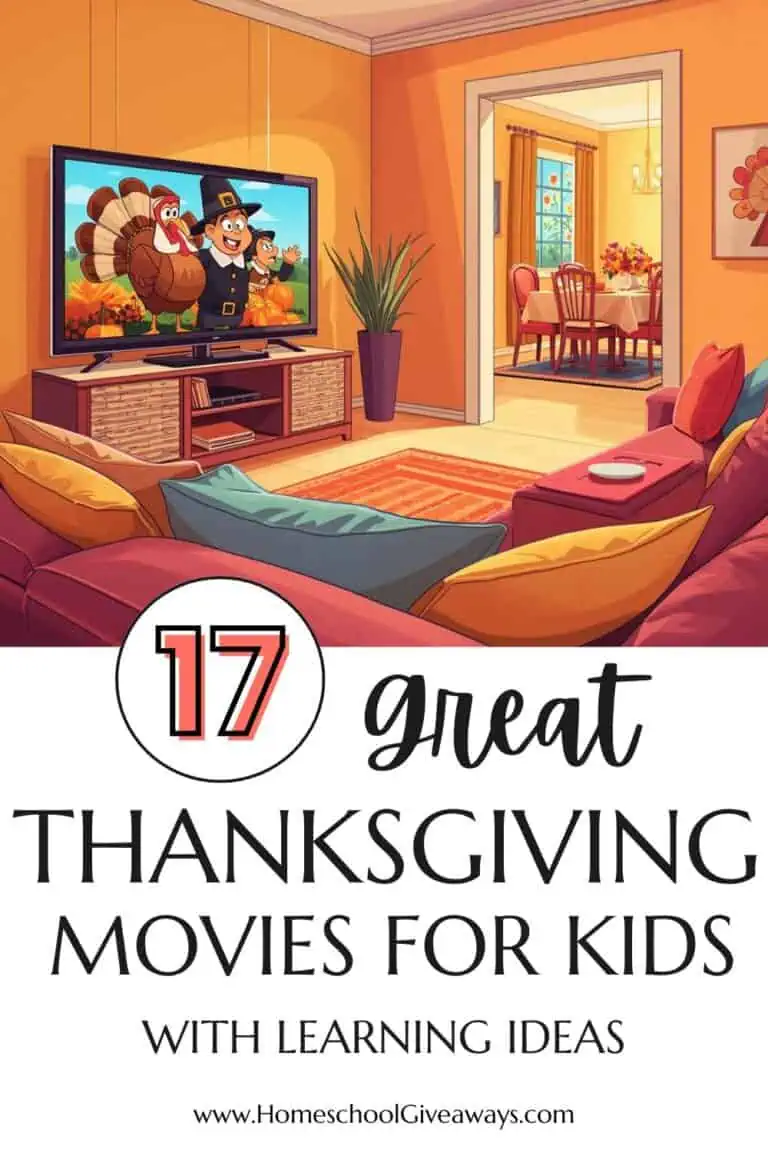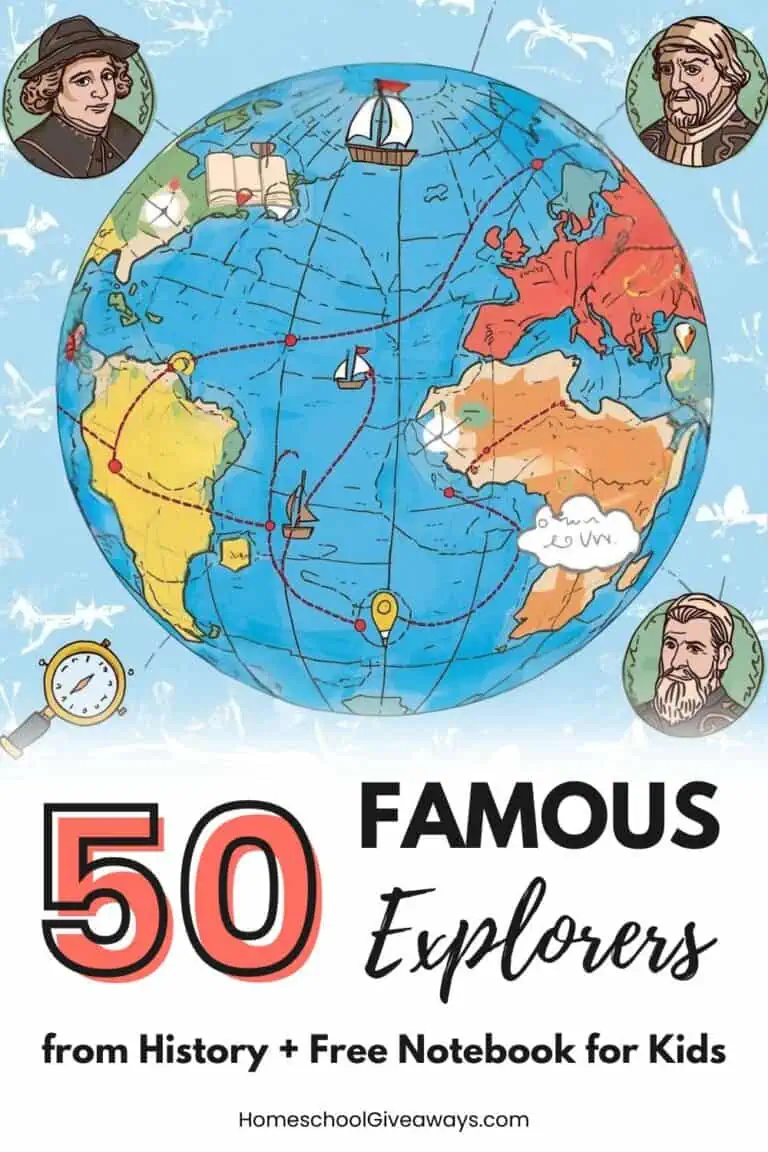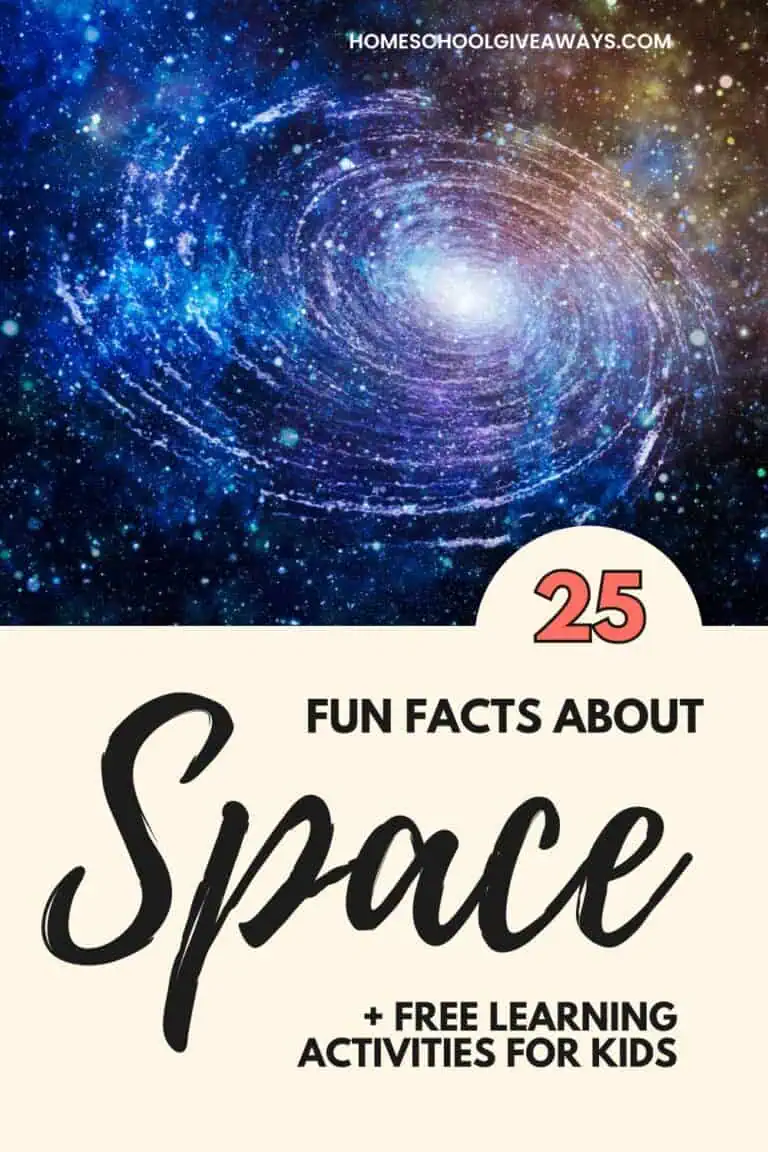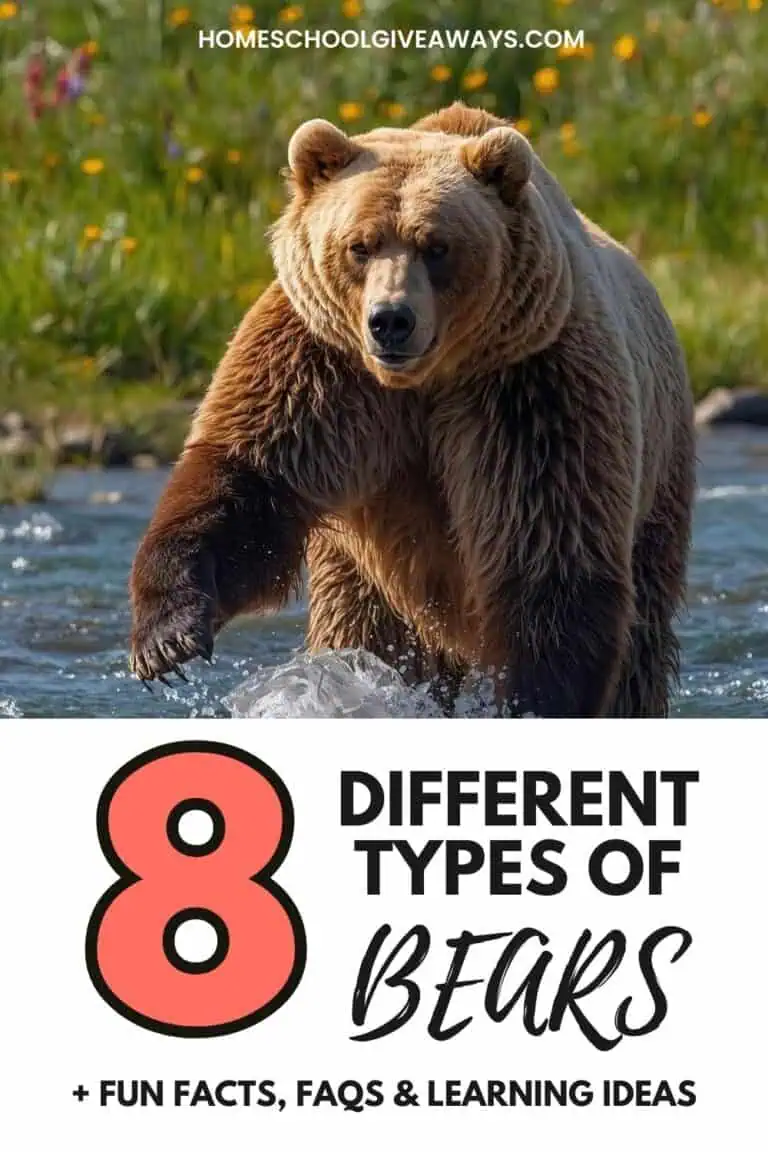Voting for Kids | 15 Hands-on Election Day Activities
Published:
October 24, 2025

Contributor:
Charis King
Disclosure: This post may contain affiliate links, meaning if you decide to make a purchase via my links, I may earn a commission at no additional cost to you. See my disclosure for more info.
Election Day is an exciting time in the United States and a perfect chance to bring voting for kids to life! Whether your learners are curious elementary students or soon-to-be teen voters, you can turn the day into a hands-on civics adventure full of history, real-world examples, and fun activities that show how our election process works, why every vote counts, and how participating in American government elections helps them become a good citizen.
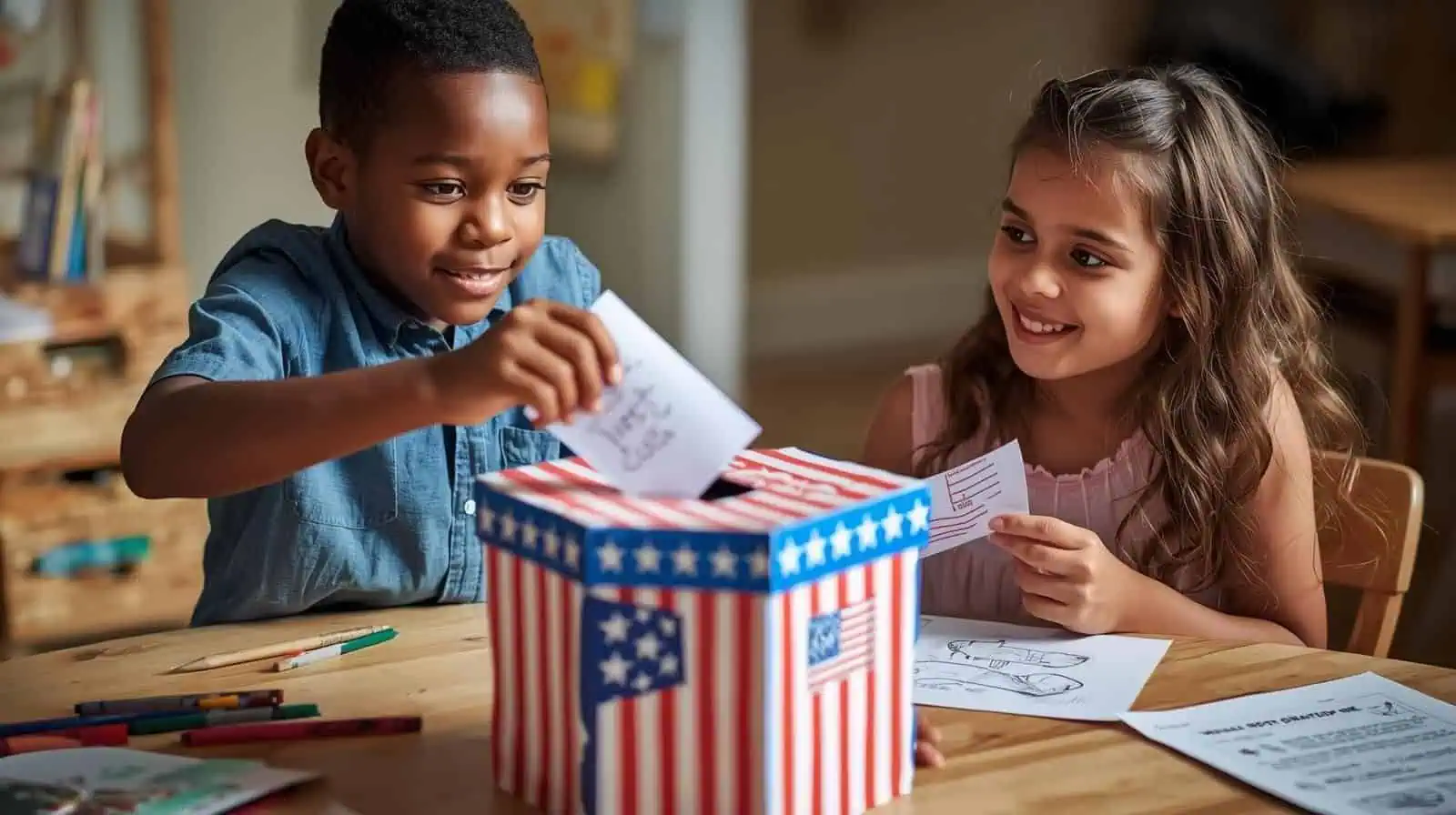
A Simple History of Voting in America
When the United States was born, the Founding Fathers were doing something bold – creating a government based on the will of the people. Most countries at the time were ruled by kings or emperors, and ordinary citizens had little to no voice. The idea that people could choose their leaders was radical.
When they wrote the Constitution, the Founders were experimenting with democracy, an idea first tried in ancient Greece. They wanted a system where citizens could vote for representatives who would make laws and decisions on their behalf, not a monarch ruling by command.
Of course, they didn’t all agree on who should be allowed to vote. Some worried that giving too many people a vote could lead to chaos; others feared that limiting it too much would make them no better than a monarchy. So they compromised.
At first, only white men who owned property could vote. Kids (and adults) might wonder why this was the case. The Founding Fathers believed that property owners had a “stake” in the country and could be trusted to make decisions about government. That left out most Americans – women, enslaved people, Native Americans, and working-class men.
But the Founders also did something incredibly wise: they created a way to change and improve the system through amendments to the Constitution. Those amendments allowed later generations to expand voting rights to more citizens.
Here’s how voting grew over time:
- 1790s: Only about six percent of Americans could vote.
- 1850s: Property rules were dropped, allowing more white men to vote.
- 1870: The 15th Amendment gave African American men the right to vote.
- 1920: The 19th Amendment granted women the right to vote.
- 1965: The Voting Rights Act outlawed racial discrimination in voting.
- 1971: The 26th Amendment lowered the voting age to 18.
Each change brought the country closer to the Founders’ ideal – that government should belong to the people.
What Happens on Election Day?
When Election Day rolls around, the first Tuesday after the first Monday in November, eligible voters head to their polling place to cast their ballot. Some people take advantage of early voting or use an absentee ballot if they can’t make it in person.
Depending on the year, voters might choose government leaders such as:
- Local and state leaders (like mayors, governors, or school board members)
- Representatives and senators for Congress
- The President and Vice President in a national election (every four years)
- Or vote on ballot initiatives – questions about laws or policies in their state
You can explain to your kids that most elections are decided by popular vote – the person or choice with the most votes wins. That’s how it works in local and state races, and even in most national elections.
But the presidential election is a little different. And that’s where the Electoral College comes in.
Understanding the Electoral College
The United States isn’t a pure democracy; it’s a republic, which means citizens elect representatives to make decisions on their behalf rather than voting on every law themselves. When the Constitution was written, large states like Virginia wanted votes to reflect population, while smaller states like Rhode Island worried they’d be ignored.
The Electoral College was the compromise. It gave every state a voice – both large and small – in choosing the President.
Here’s how it works today:
- Each state gets electoral votes equal to its number of senators (2) plus its number of House representatives.
- There are 538 total electoral votes (including 3 for Washington, D.C.).
- To win, a candidate needs 270 votes or just over half.
- When citizens vote, they’re actually voting for electors who promise to vote for their chosen presidential candidate.
- The electors meet and officially vote for President and Vice President based on the results of their state.
This system means it’s possible for a candidate to win the popular vote but lose the Electoral College, which has happened a few times, including in 2000 and 2016.
It’s a fascinating example of how the Founders balanced federalism, power shared between national and state governments, so both people and states would have a say.
A Homeschool Example: The Family Field Trip Election
To help kids understand the electoral process, try this fun homeschool example using a mock electoral vote.
Imagine ten families in your co-op are participating in a family vote on a field trip. If it were a popular vote, the biggest families could decide the trip for everyone! But if you assign each family a mix of “parent votes” and “child votes” – kind of like states getting electoral votes for a combination of their senators and representatives – smaller families have a voice too.
Popular Vote: This shows the actual number of people voting in each family. Parents and kids each get one vote.
| Family | Parents | Kids | Total People Votes |
|---|---|---|---|
| A | 2 | 10 | 12 |
| B | 1 | 3 | 4 |
| C | 2 | 1 | 3 |
| D | 1 | 1 | 2 |
| E | 1 | 3 | 4 |
| F | 1 | 2 | 3 |
| G | 1 | 3 | 4 |
| H | 1 | 6 | 7 |
| I | 2 | 5 | 7 |
| J | 2 | 2 | 4 |
| Totals | 14 parents | 35 kids | 49 total votes |
Electoral Vote: This shows the “Electoral College” version. The parents get 1 vote total, and children’s votes are weighted: 1–4 kids = 1 vote, 5–8 kids = 2 votes, 9–12 kids = 3 votes.
| Family | Parent Votes | Child Votes | Total Electoral Votes |
|---|---|---|---|
| A | 1 | 3 | 4 |
| B | 1 | 1 | 2 |
| C | 1 | 1 | 2 |
| D | 1 | 1 | 2 |
| E | 1 | 1 | 2 |
| F | 1 | 1 | 2 |
| G | 1 | 1 | 2 |
| H | 1 | 2 | 3 |
| I | 1 | 2 | 3 |
| J | 1 | 1 | 2 |
| Totals | 10 parent votes | 14 child votes | 24 total electoral votes |
In the popular vote option, every person in each family gets a vote. That means the three largest families (A, H, I) could decide the outcome every time without any input from the smaller families.
But with the electoral vote model, smaller families have influence too as it takes five families to reach a majority of 13 votes.
That is exactly how the Electoral College system gives smaller states a voice while still giving a larger states representation.
Take the time to debate the 2 options in your family, class or co-op. Which system feels fairer? Which one do you think should be used to elect a President of the Unites States?
Midterm Elections and More
Not every election is for President. Midterm elections happen halfway through a presidential term. During those years, voters choose all 435 members of the House of Representatives and about one-third of the Senate. These elections can shift which political party controls Congress and can affect how easily and which new laws are passed.
It’s a good time to remind your kids that every election matters, not just the big presidential ones. Local and state leaders make important decisions too!
Voting for Kids: FAQ
Here are some important questions kids often ask about voting with answers to help make Election Day understandable.
- Why is voting important?
Voting is how citizens have a say in the leaders and laws that affect their lives. Every vote helps shape the community, state, and country, making it a powerful way to participate in the democratic process.
- Why is the Electoral College important?
The Electoral College balances power between big and small states when choosing the President. It makes sure every state has a voice, not just the most populated ones. Without it, presidential candidates could campaign only in the high population states and completely skip the smaller states because their vote wouldn’t change the outcome.
- Is voting a civil right?
Yes! Laws like the 15th and 19th Amendments and the Voting Rights Act helped ensure that more people could vote, no matter their race or gender.
- Who is allowed to vote?
In the U.S., most citizens who are 18 or older and meet their state’s registration requirements can vote. Some groups, like non-citizens or people under 18, usually cannot.
- When are presidential elections held?
Presidential elections happen every four years on the first Tuesday after the first Monday in November. Midterm elections happen halfway through a president’s term, choosing members of Congress, and local and state elections happen at different times depending on your state.
- What’s the difference between local, state, and national elections?
Local elections pick leaders like mayors or school boards. State elections pick governors and state lawmakers. National elections pick the President, Vice President, and members of Congress. Every level affects people’s daily lives.
Print & Go Giveaway: Free Election Day Worksheets for Kids
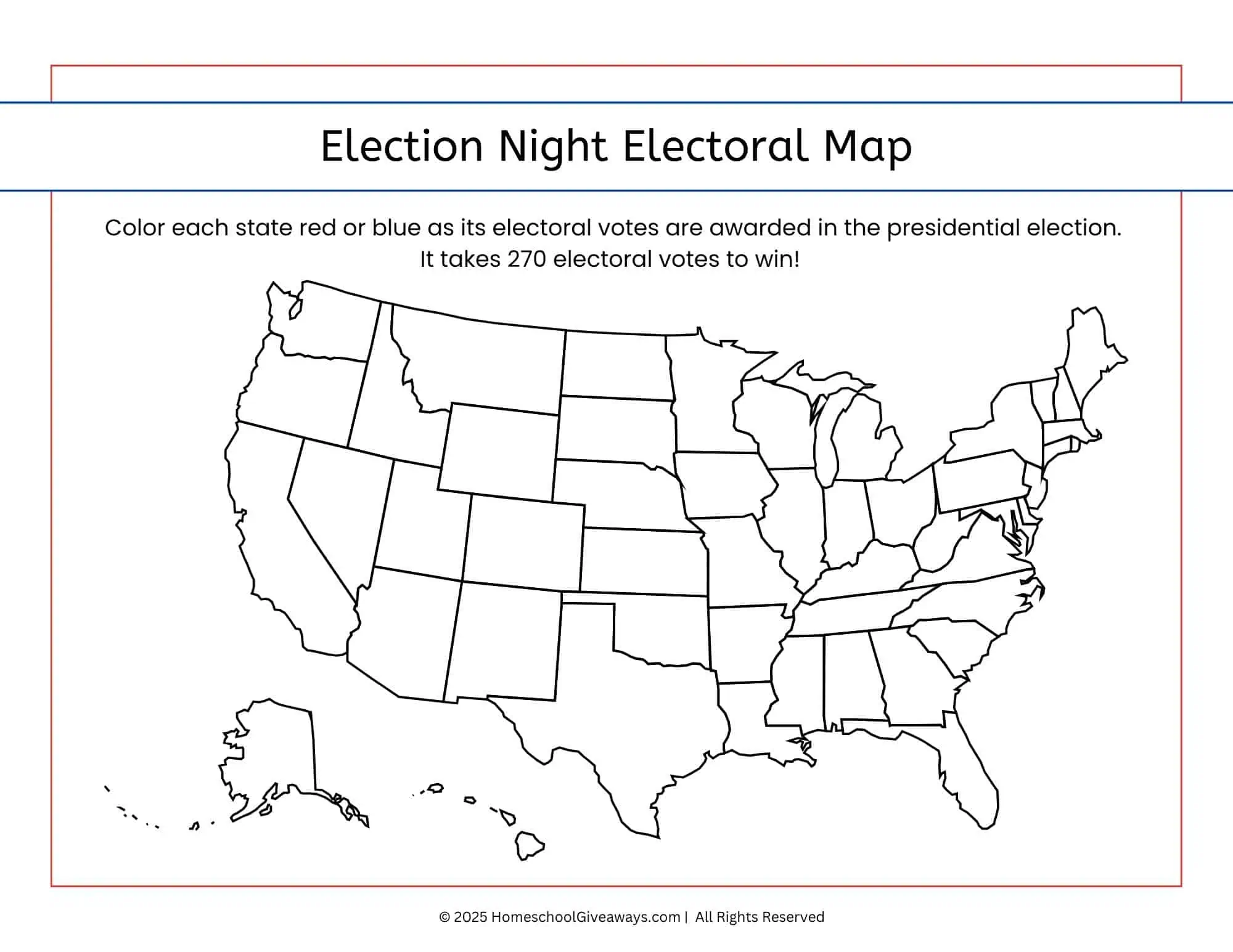
Turn Election Night into a hands-on civics and geography lesson! Kids can color each state red or blue as electoral votes are announced and watch the race to 270 unfold in real time.
They can also use the map to practice identifying and labeling each state, helping them learn U.S. geography at the same time.
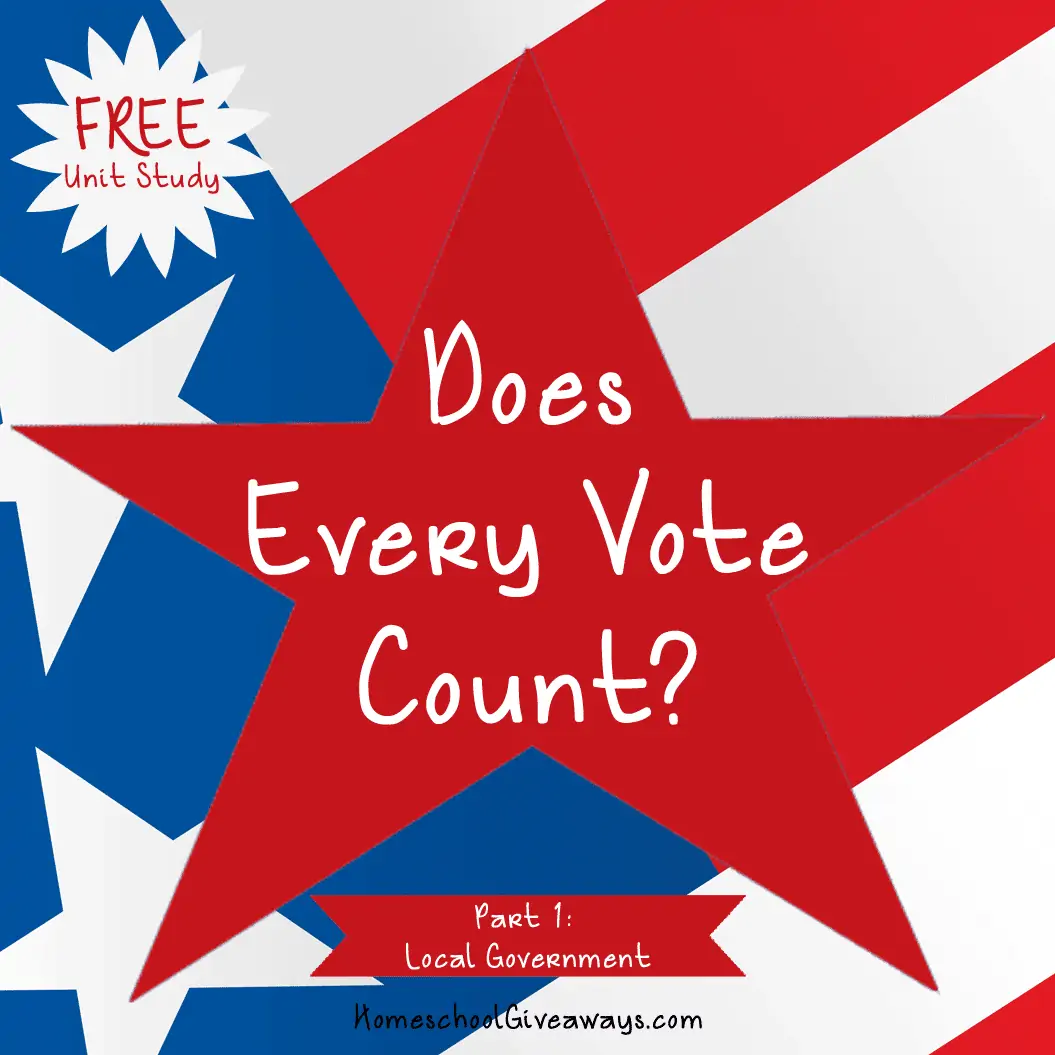
Does Every Vote Count – 4-Week Unit Study
Help your middle and high school students dive deep into how our government works with this FREE instant download from WriteBonnieRose.com. This 4-week unit study walks students through:
- Part 1: Local Government
- Part 2: State Government
- Part 3: Federal Government
- Part 4: The Supreme Court
It’s a simple, ready-to-go way to explore the big questions about voting, civic responsibility, and how every vote truly matters. Perfect for homeschoolers looking for a hands-on, high school-level civics experience! (Note: This unit study can also be found in our searchable All-Access Library.)
Hands-On Learning Ideas for Kids
Learning about voting doesn’t have to just stay on paper. You can make it real, hands-on, and fun for your homeschool! Here are some ideas to try with your kids and teens as election day approaches:
- Election Timeline Project – Create a visual timeline of how voting rights have expanded in the U.S. Kids can illustrate the 15th and 19th Amendments, the Voting Rights Act, and the 26th Amendment to see history in action.
- Learn About Your Representatives – Find out who your local congressman, senators, or school board members and research what they do. Kids can write letters or emails asking questions and even try to meet their representatives in person. Visiting a local office or scheduling a short meeting can make civic engagement real and memorable.
- Visit Your State Capital – Turn a field trip into a civics lesson! Seeing the state capitol building, touring the chambers, or watching a committee session gives kids of all ages a tangible sense of how government works.
- Voting Vocabulary Game – Learn key terms like ballot, referendum, electoral vote, amendment, or civil right. Use word searches, flashcards, or matching games so kids understand the language of elections before they start participating.
- Track Real Elections That Affect Them / Learn About Ballot Initiatives – Research the elections that affect your family and community including local, state, and national races. Look at candidates and any ballot initiatives. Make charts, posters, or mini fact sheets to help kids discover why or how those issues and races might affect to your family.
- Voter Registration for Teens – If your teen is old enough, help them complete their voter registration for the next election so they can vote for the first time. Walk through the official steps online or at your local election office. Make sure they understand deadlines, eligibility requirements, and how to confirm their registration.
- Create a Mock Ballot Initiative – Let your kids propose a “law” for the household such as maybe “Extra Recess Day” or “Pizza Fridays.” They can design posters, campaign, give speeches or debate the topic, and vote. It’s a fun way to understand how ballot initiatives work.
- Candidate Posters – Have kids design posters for their candidates, mock ballot initiative or choices. Hang them up and let “campaign speeches” be one to five minutes each, It’s a creative way to practice persuasion.
- Host a Family, Class or Co-op Election – Create ballots, a ballot box, and voting slips. Let kids nominate candidates for a fun topic like a fun course or field trip (e.g., nature science day, art workshop). Carry out the vote and discuss the results.
- Vote with Stickers – Younger children can practice voting with a sticker chart for quick family decisions. Count the votes together and discuss the results.
- Take Your Kids to Watch You Vote – More is caught than taught! Let your kids see the whole process in action, from checking in to casting a ballot, when they go with you to vote. Talk through each step and answer their questions so they understand how to vote and why voting is important.
- Calculate the Percent of Electoral Votes – Here’s a math activity to try. Give your kids a list of states with their number of electoral votes (or have older kids research and find the numbers themselves). Older students can calculate what percent of the total 538 each state represents and/or create a bar graph or pie chart with the results to see which states hold the most voting power. Younger children can put the states in order from smallest to largest based on their number of electoral votes.
- Color an Electoral Map on Election Night – Print a blank U.S. map (like the free one above) and have them color in states either red or blue as the results are announced in the next presidential election.
- Follow Election Night Results – Pick a few races an/or local ballot issues to watch. Kids can track electoral votes vs. popular votes per state during a presidential election, see the trends over the country, or just cheer for the candidates or issues family members are rooting for.
- Day After the Election Graph – Discuss how many states each candidate won in a presidential election, which candidates won, how many ballot issues passed or were defeated, etc. Did the results go the way you wanted them to?
Books & Resources about Voting for Kids & Teens
Be sure to grab some books and other resources to add another way to learn about voting. Here’s a few options to try:
- If I Ran for President by Catherine Stier – Imagine running for president yourself! This fun, lively book takes your kids inside the campaign process and shows how voting really works. It is a perfect introduction for curious young learners.
- One Vote, Two Vote, I Vote, You Vote by Bonnie Worth – Get ready to cheer for democracy! This playful, engaging book explains why every vote counts and helps kids see themselves as part of the voting process.
- Vote! by Eileen Christelow – Simple, clear, and fun. This book makes the idea of voting easy to understand while showing why it matters in your everyday life.
- Elections and Voting For Kids! by Bond and Bexley- Take a closer look at how elections work and who gets to vote. This book gives kids the scoop on ballots, candidates, and the importance of civic participation.
- The Voting Booth by Brandy Colbert – Follow two teens on their first Election Day and watch them navigate real issues, first votes, and civic responsibility. It is a relatable story that shows why voting matters today.
- Votes for Women!: American Suffragists and the Battle for the Ballot by Winifred Conkling – Step back in time and meet the brave women who fought for the right to vote. Your kids will see how determination and courage changed history forever.
FREE Sonlight Elections Unit Study

Give your kids ages 8-12 a hands-on look at elections with this engaging FREE homeschool unit study from Sonlight. It walks students through campaigns, the voting process, and why every vote matters. Another educational way to bring Election Day lessons to life.
Voting Videos & Interactive Learning
- I’m Gonna Send Your Vote to College by Schoolhouse Rock – This catchy, fun song turns learning about voting into a sing-along experience. Your kids will enjoy the music while picking up important concepts about elections, how votes are counted, and why participation matters.
- Election Day for Kids – This engaging video from Twinkl USA introduces children to the significance of Election Day. It covers essential topics like the importance of voting, who has the right to vote, and the role of the Electoral College.
- 12 Great Videos to Teach Students about Elections and Voting – Check out this group of videos for kids of multiple ages. Includes Sesame Street videos, history of voting, explanation of the Electoral College, and more.
- iCivics: Cast Your Vote – Step into the world of campaigns and elections! This interactive game lets your kids run for office, make decisions, and cast votes, helping them see how elections really work.
- Ben’s Guide to the U.S. Government – Explore the U.S. government at your own pace. Your kids can learn about elections, the Constitution, and civic responsibilities with clear explanations and kid-friendly activities.
- Kids.gov Elections Page – Discover the voting process in a way your kids can understand. This site explains elections, ballot initiatives, and civic duties, helping them see why every vote matters.
Make Your Voice Heard
If your homeschool student is 18 or older, voting is one of the most meaningful ways to take part in civic life. Whether it’s a local election or a national one, every ballot counts – and your family’s voice matters.
Start by helping your teen register at Vote.gov. The official government site that walks you step by step through how to register online, by mail, or in person. It’s simple, secure, and takes only a few minutes.
If you’d like to take things a step further, explore The Civics Center – How to Run a Drive: Teacher Edition. While designed for schools, it’s perfect for co-ops or homeschool groups too. You’ll find everything you need, including nonpartisan classroom resources, to host a voter registration drive and show your teens how civic engagement works in the real world.
By getting involved together, you’re showing your kids that voting isn’t just a right but a responsibility, a powerful way to make a difference, and a way to encourage lifelong voting habits.
Wrap-Up
The Founding Fathers built a system that wasn’t perfect but they gave us something incredible: the ability to make it better. Every generation since has expanded the right to vote and strengthened our democracy.
By helping your kids understand how voting works and why it matters, you’re raising the next generation of informed, responsible citizens who understand the workings of the U.S. government. And that’s something worth celebrating every Election Day.

